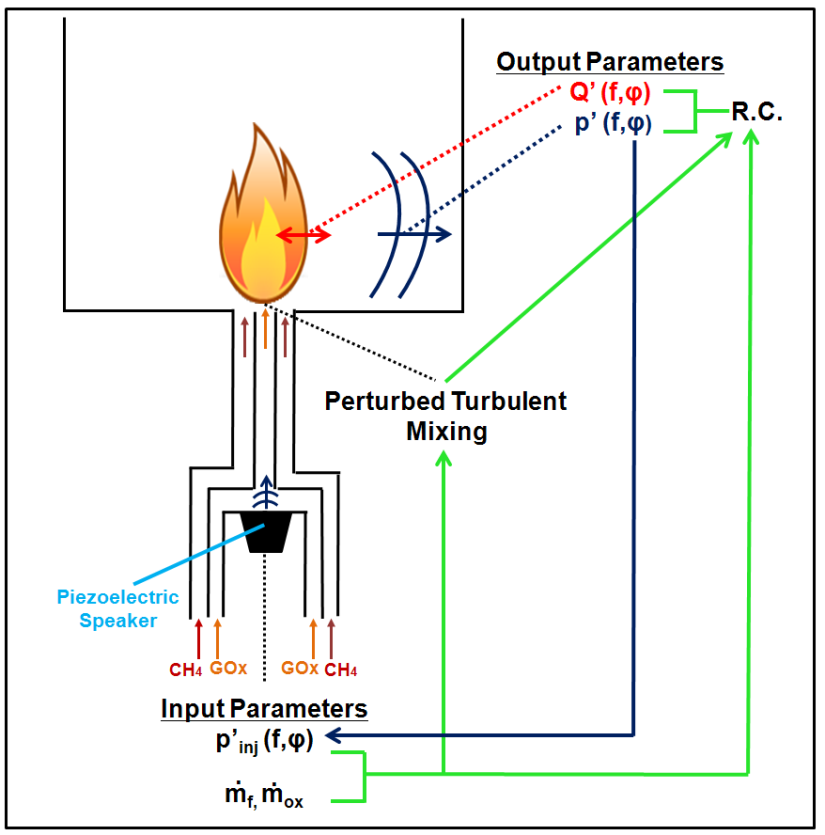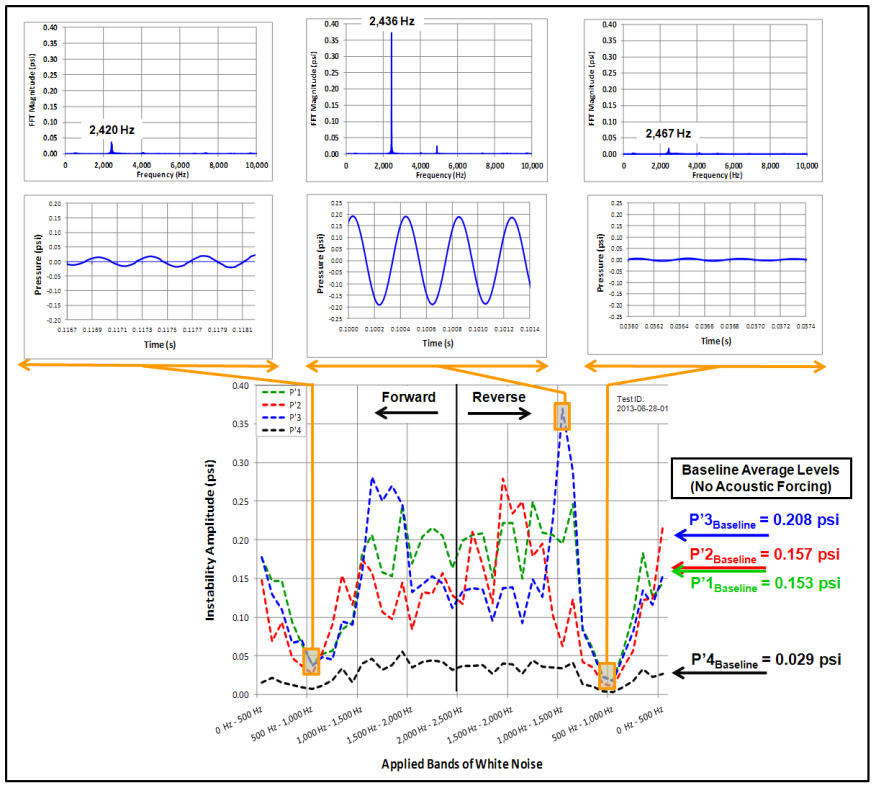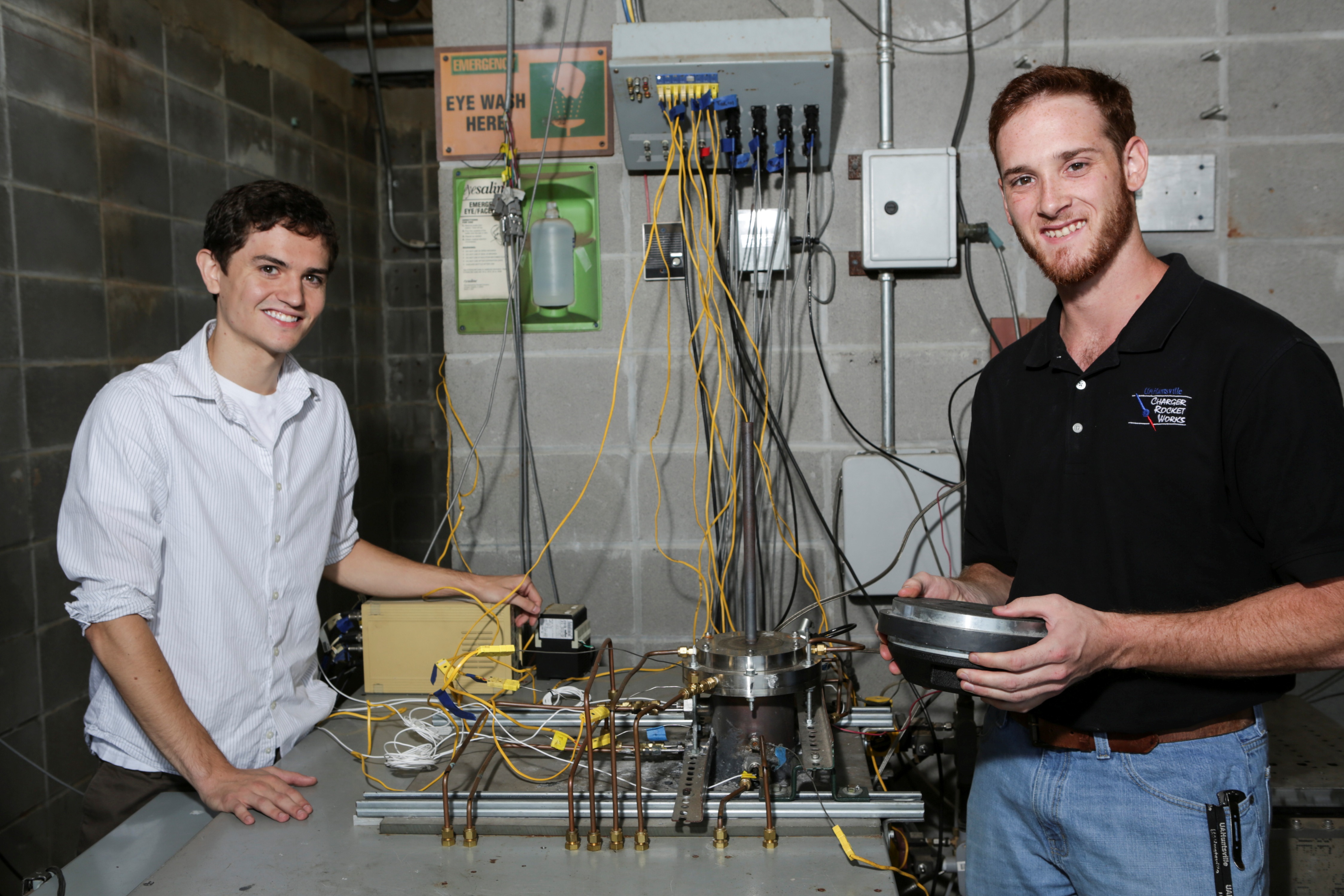Combustion instabilities can make a rocket engine have a really bad day. High frequency combustion instabilities are periodic oscillations of combustion that occur due to the coupled interaction between unsteady heat release from combustion, acoustic fluctuations within the combustor, and perturbations of the incoming propellant.
These instabilities become excited at specific frequencies, and if their amplitudes become exceedingly large, a total failure of the chamber is possible through increased heat transfer to the engine walls or large amplitude structural vibrations—in short, an explosion.
Even 50 years after the development of the F-1, the main engine used in the first stage of the Saturn V, the onset of detrimental combustion instabilities continues to be an obstacle for rocket engine developers.

Historically, suppression of combustion instabilities has been achieved through the use of baffle systems, as in the F-1 engine, or alterations to the injector sprays. Today, these historical techniques continue to advance, yet new and completely novel suppression methods emerge as the engineering quest for efficient design evolves. Recent work with mechanical valves that modulate the incoming propellant flow at specific frequencies to dampen instability provided the background for current research at UAH’s Propulsion Research Center.
The author, a University of Alabama in Huntsville (UAH) graduate student and Von Braun Propulsion Fellow, is working with a research team at the UAH Propulsion Research Center to look at an instability suppression technique to control the oscillatory behavior within liquid rocket engine combustors by acoustically modulating the incoming propellant. The author’s acoustic modulation technique dampens harmful instabilities by applying white noise from an acoustic speaker. In this research, a piezoelectric speaker is housed at the base of the oxidizer post of a propellant injector, upstream of the combustor. The speaker outputs a packet of frequencies, also known as band-limited white noise, within a certain frequency range to neutralize instabilities in a more reliable fashion.
Working with UAH senior aerospace student Jacob Cranford, the author built a model liquid rocket engine combustor at the UAH Propulsion Research Center to test the concept. The combustion instability test facility used is a single-element combustor that burns gaseous methane and oxygen, where a 2,400 Hz instability is purposely excited in order to study the phenomenon. The combustion chamber is outfitted with four pressure transducers to measure the acoustic pressure fluctuations of the instability at locations throughout the combustor.
During a test, the 2,400 Hz instability is spontaneously excited within the combustor. The speaker is set to output varying bands of white noise at constant amplitude, equal to as that of the instability. Beginning with f = 0 Hz – 500 Hz, bands of 500 Hz are applied in increments of 100 Hz, until 2,000 Hz – 2,500 Hz and then back down all the way to 0 Hz – 500 Hz. By sweeping across this range, the optimal frequency band leading to the largest instability suppression can be found.

Data from one of these tests can be seen in the figure above, which shows the pressure amplitude of the 2,400 Hz instability measured from the four pressure transducers at each band of white noise applied, in both the forward and reverse directions. Applying 500 Hz–1,000 Hz band-limited white noise (at a constant amplitude of 0.3 psi RMS) yields maximum suppression of the 2,400 Hz instability.
The author recently had the opportunity to go to Hawthorne, Calif., to present this research to engineers at SpaceX. The company requested he do so after the author presented two papers about the research at this year’s AIAA Joint Propulsion Conference, July 14–17 in San Jose, Calif. (“Overview of Combustion Instabilities in Liquid Rocket Engines – Coupling Mechanisms & Control Techniques,” John W. Bennewitz and Robert A. Frederick; American Institute of Aeronautics and Astronautics; and “Application of High Frequency Pressure Disturbances as a Control Mechanism for Liquid Rocket Engine Combustion Instabilities,” John W. Bennewitz, David M. Lineberry and Robert A. Frederick; American Institute of Aeronautics and Astronautics). The author also placed first in the field of Engineering at the 6th Wernher von Braun Memorial Symposium Student Poster Competition for this research.
“John has combined his enthusiasm with a disciplined look at the literature and a creative approach to discover an effective strategy for eliminating combustion instability that could find its way into practical applications,” says faculty advisor Dr. Robert Frederick, professor and Director of the UAH Propulsion Research Center.

The author and Cranford are continuing to perfect this instability mitigation technique by running volume and frequency band sensitivity studies. There are also plans to include optical diagnostics within the combustor, which will provide a greater understanding of how the oscillatory behavior of the combustor is affected by the application of band limited white noise. This could hopefully lead to a more efficient design approach to liquid rocket engines in the future—and a reduced risk of an explosion, clearly a positive development in liquid rocket propulsion development.
Note: The author, John Bennewitz, is a University of Alabama in Huntsville (UAH) graduate student, Von Braun Propulsion Fellow, and works with a research team at the UAH Propulsion Research Center.
The Propulsion Research Center at the University of Alabama in Huntsville connects the academic research community with industry and government to advance basic research and develop technology related to propulsion and energy. The center currently performs about $2.5 million in research per year in conventional and advanced propulsion disciplines including solid, liquid, air-breathing, and plasma propulsion. The The Propulsion Research Center strives to be a major generator of talent and innovative solutions in propulsion and energy-related technologies. More information at http://www.uah.edu/prc.
Want to keep up-to-date with all things space? Be sure to “Like” AmericaSpace on Facebook and follow us on Twitter: @AmericaSpace



